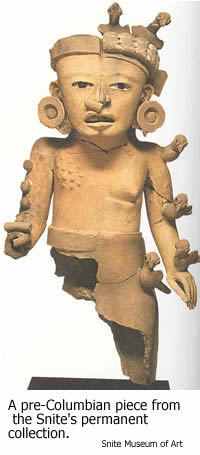
A temple graced Notre Dame’s campus this winter.
Actually it was a replica of a temple—the earliest monumental temple in Greece, built around 675 B.C.—and it was the fruit of The Project for the Study and Publication of Greek Stone Architecture at Corinth, directed by Robin Rhodes of the Department of Art, Art History and Design. The replica and an exhibit on the project were on display in the Mestrovic Gallery at the Snite Museum of Art from January 20 to March 19.
Rhodes and his team of Notre Dame alumni and students began field work in 1999 by examining hundreds of scattered and broken stones and tiles found on a hill in what was ancient Corinth. Using such clues as shape and texture, the team deduced the purpose of each fragment and visualized how the temple was constructed. The Snite exhibit included a computerized depiction of the reconstruction process, as well as precise models of the stones and tiles the team worked with, full-scale replicas of portions of the temple, and a 1:25 scale replica of the entire temple set against video projections of the surrounding Greek landscape.
“All of this is unique,” Rhodes says. “There has never been an exhibition like this.”
The exhibition visited the Snite two months after the museum celebrated its 25th anniversary last November. Charles Loving, the museum’s director, says Rhodes’ and other University exhibitions serve one of the museum’s two primary audiences: the faculty, staff and students of Notre Dame. The museum’s other primary audience is the local community, particularly schoolchildren, to which the museum offers a variety of tours and academic programs. Loving estimates the museum draws 5,000 local students every year.
That figure is a testament to how far the museum has evolved in 25 years. The Snite was constructed in 1980 as an extension to the O’Shaughnessy Hall Art Gallery, which the University’s art collection was outgrowing. At that time, the collection numbered around 12,000 works. It now has almost doubled. “The construction of [the Snite] building was the catalyst for the major development of collections,” Loving says. “This institution has seen very dramatic growth in a relatively short period of time.”
The museum used to aspire to be a general encyclopedic museum, with works from all cultures and time periods, Loving says. But because larger museums in the Midwest, such as the Art Institute of Chicago, are better suited to that purpose, the museum now tries to focus on its strengths. Those include old master drawings, 19th century European photography, decorative arts and pre-Columbian art.
Loving tells of a visit to the Snite from Michael Coe of Yale University, whom he calls the great-grandfather of pre-Columbian art: “As I was driving him to the airport he said, ‘You have the best Olmec collection in the country.’” When Loving asked if he meant the best Olmec collection at a university museum, Coe responded, “No, you have the best Olmec collection in the country.”
Despite the Snite’s stellar pre-Columbian collection and its other strengths, the museum was long regarded as the University’s “best-kept secret,” Loving says. The museum has tried to shake that reputation in recent years through better public relations and marketing. The Snite is frequently the subject of articles and advertisements in the South Bend Tribune, and the museum’s marketing and public relations specialist, Gina Costa, hosts a radio show. The Snite also received mention in last year’s football programs. “I think awareness of the museum is much greater than it has been before,” Loving says.
But Loving would like the museum in its next 25 years to play an even more prominent role at the University and in the surrounding community. “We have a current need for a new building, and our dream is to create a fine arts district near the DeBartolo Performing Arts Center,” he says.
The University is holding a spot for a new museum adjacent to the performing arts center. That location would cater to the campus audience by bringing together the visual and the performing arts, and it would cater to the general public by offering easier access to the museum. “The perimeter of campus is exactly the perfect place for us,” Loving says.